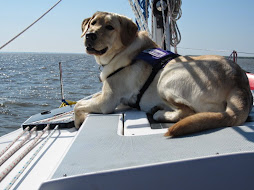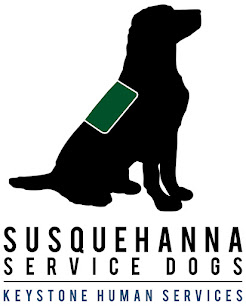Post by Nancy Fierer,
SSD’s director
The Assistance Dogs International North American Trainer’s
Conference, hosted by Pacific Assistance Dogs Society (PADS) in Vancouver, British
Columbia, Canada, was wonderful. It was full of diverse material with something
interesting for everyone. PADS arranged for the conference to be held at the
Rosemary Heights Retreat Center just outside Vancouver. We had wonderfully
comfortable beds, great food, and beautiful grounds for walking.
Many attendees arrived on Sunday evening (Oct. 6) to settle
in, and there was a dinner and later a wine and cheese reception. It was great
to see old friends and greet new ones. In addition to me, there were three
other people representing SSD at the conference: Amanda, our training
coordinator; Becky, our puppy coordinator; and Susan, our volunteer
extraordinaire. SSD Julia, one of our yellow lab breeding females, also came
along.
On Monday morning, we had a great session about courthouse
dogs. Celeste Walsen Ellen O’Neill-Stephens, and CCI Molly B gave a wonderful
presentation about what they do, how it works, and some of the wonderful
successes they have had. Kim Gramlich with PADS Caber from the Delta Police
Department spoke about the use of a specially trained dog in police-based
victim services. The dog provides emotional support and aid during crisis
intervention and response. The dog is a very effective tool, often giving
“permission” for emotions that are under the surface, which allows the healing
process to begin. This was a different type of facility placement from an ADI
program than I had seen before. I found this session to be very informative and
professional.
The women from the Courthouse Dog Foundation stress how
careful and thorough the training and placement must be for courthouse dogs
because these dogs are now part of making case law to smooth the way for future
courthouse dogs. There are now fifty of these facility courthouse dogs working
in twenty-one states. The third part of this session concerned the placement of
facility dogs by PADS in a child protection center. Here again, professionalism
was stressed. Margaret Hicks, PADS training manager did another great job with
this final presentation.
After lunch, Susquehanna Service Dogs “Make the Right
Match,” a presentation about matching people with dogs. Rebecca Lamb, our puppy
coordinator, began by discussing the extensive process each potential puppy
raiser must go through before we match the puppy with the raiser family. I gave
a brief overview of the application process for people who are applying for
service dogs, targeting the areas where we gather information for the future
match, as well as information to measure how well the service dog team is doing
six months after placement. Amanda Nicholson, our training coordinator, talked
about the process of matching a person with a service dog. She discussed the
questions we ask each person before they meet the dogs, which are used in outcome
measurements and to create a list of behaviors and tasks needed to mitigate the
person’s disability. She listed all of the things we consider before matching a
person with a dog, including some of the common pitfalls. We also consider the
dog’s choice as well. There were many questions for us, since the information
was new for some people.
Next we had breakout sessions in three areas—Diabetic Dogs
Panel, Starting a Courthouse Program, and a Breeding Program Managers session.
I attended Starting a Courthouse Program, since we recently placed our first
courthouse dog (SSD Buster). This session was very informative, and people made
specific and systematic suggestions.
The evening was another fun time. Everyone shared funny and
embarrassing moments involving service dogs in their lives. Marina Hall
Phillips won the prize for the funniest, and I still laugh thinking about it.
Tuesday, October 8 was a day full of serious breeding
discussions. In the morning sessions, Marina Hall Phillips discussed the ins and
outs of managing a productive and sustainable working dog breeding colony. She
stress the importance of knowing your production value and the significance of
data integrity and phenotype, as well as what tests we need and why.
In February, SSD had hired Marina to visit our program for
three days to help evaluate our needs. Much of the information in this session
were things we learned from her visit and the follow-up report we received. The
session was a comprehensive overview and a great reminder for us to help keep
us on track. This was an awesome presentation!
That afternoon, Marina moderated a panel discussion with
presenters from PADS, SSD, Indiana Canine Assistant Network (ICAN), and British
Columbia Guide Dogs. The audience had lots of questions.
The final session of the day concerned the Assistance Dogs International
North America Breeding Cooperative (ABC), and again, there were many questions.
ABC was recently created, and we are a host member. (Read more about ABC.)
In the evening, the potential males from PADS were assessed.
We discussed the issue of looking at the dog as an individual vs. the big
picture. How much weight is given to the individual and what other important
considerations need to be taken based on the dog’s pedigree? We also discussed
the importance of weighing the dog’s faults and merits and not letting
“perfect” be the enemy of “good.” Finally, we looked at pre-breeding management
of broods and studs. It was a long but interesting exercise.
Wednesday, October 9 brought a slide and video presentation
by Joey Iverson about Behavioral Adjustment Training (BAT). The presentation
showed the systematic approach to using BAT to rehabilitate dog reactivity by
examining why the dog is reactive and helping the dog meet their needs in other
ways. BAT is a dog-friendly application of functional analysis that gives the
dogs a chance to learn to control their own comfort level through peaceful
means. I really enjoyed this presentation made it clearer to me how SSD can
improve the way we use BAT. I find BAT helpful for reactivity for puppies and
young dogs, but not necessarily for addressing aggressive behavior.
In the afternoon, we listened to a presentation by PADS
puppy raising supervisor Heather Kidd on Footfall Techniques. She came up with
the idea after working with her horses. She feels that if you teach the pup
efficient footwork as puppies, then they will be able to become more confident
as adults. They are able to move more efficiently and also be more confident
that their feet will move them where they need to go in times of stress.
Heather demonstrated that confidence in a wonderful video of a PADS dog and a
ramp. I think the footfall techniques are something that SSD will start teaching.
It’s easy, fun, and may be very helpful in the future.
We then had a hands-on workshop with BAT and footfall
techniques, which was nice for the last
day.
Most of the attendees returned home on October 10, but we decided
to take advantage of the visit to PADS and the trip to Whistler BC. It was a
beautiful day, with wonderful scenery, great company, and a reminder of how
proud Canadians are of their wonderful country!




































